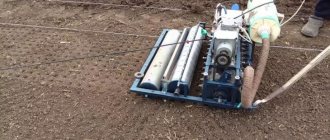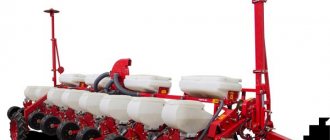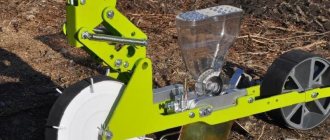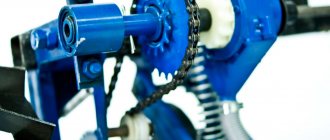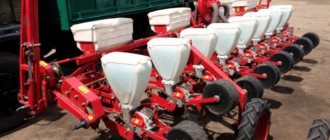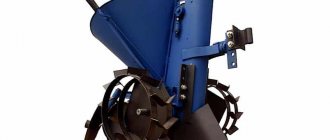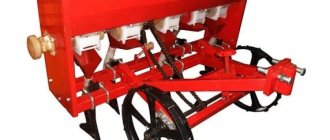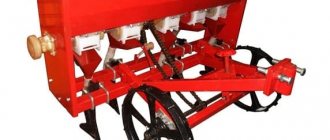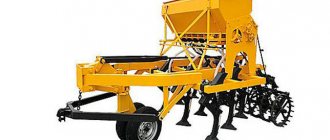Few of the lucky people who have acquired a dacha or country plot for the first time use mechanization means when sowing lawns. Most people find it unwise to spend money on a device that they think they will only need once a year at best.
But when uneven shoots appear, it becomes clear that the lawn seeder and the costs of purchasing it are well worth the time spent in painstaking manual labor. What this device can be used for, in addition to its main purpose, how to choose the most suitable model, and how much it will cost, will be discussed below.
Functionality
The main purpose of the seeder follows from its name - uniform sowing of seeds. But, most of these devices can also be used to evenly distribute various powder or granular preparations over the surface.
A seeder can help:
- Apply mineral fertilizers, dolomite flour, and chalk to the soil.
- Spread pest control products throughout your lawn or garden.
- Distribute de-icers along the street and walkways in winter.
It is important that mechanization not only reduces time spent on manual labor, but also protects against excessively frequent and close contact with chemicals.
Advantages
A manual single-row precision seed drill will help you quickly and efficiently sow a garden bed, vegetable garden or field. It makes the gardener’s work much easier, since you don’t have to bend over to make a hole and place the seed in the ground. A specially thought-out design simultaneously makes a furrow, introduces seed material into the soil, digs it in, and marks a furrow for the next row.
The use of a seeder is considered effective and appropriate, since it:
- increases labor productivity;
- reduces production costs;
- helps to increase the profitability of growing vegetable crops;
- reduces the cost of obtaining a unit of production;
- reduces the time it takes for breeders to create new varieties;
- prevents overconsumption of valuable seed material;
Experts say that as a result of using such technology, productivity increases by 10-15%, and seed consumption decreases by 18-20%.
Classification
According to the principle of action, they are distinguished:
- Centrifugal seeders contain a rotating disc that scatters the seeds in a circle.
- Row seeders, in which seeds are poured out in rows from a hopper containing them.
Centrifugal seeders provide high speed operation, but require certain skills and habituation, without which flaws are possible. All manual and some self-propelled seeders are based on this principle. Row seeders are slower but provide high seeding uniformity.
Centrifugal seeders
According to the control method they are distinguished:
| Control type | Design Features | Method of use and purpose |
| Manual seeders | A container for seeds equipped with a rotary centrifugal mechanism that scatters them in a circle. | Holding the device in one hand, the sower turns the handle of the mechanism with the other, moving across the sown area. Designed for sowing small areas and correcting lawn defects. |
| Wheeled manual | A trolley with a hopper for seeds, which are poured out in rows through special holes. | The operator rolls the cart in front of him, opening or closing the holes as necessary. Designed for medium-sized lawns. |
| Self-propelled | Wheeled seeders equipped with a battery and an electric motor that provide their movement. They can carry out row sowing or be equipped with a centrifugal circular sowing device. | Semi-automatic control, a number of additional functions. Can be used for sowing over large areas. |
| Trailed | Wheeled row seeders designed to be coupled to a mini-tractor or walk-behind tractor. | Professional devices used on football and golf fields, in public gardens and other urban green areas. |
Design
The design of the precision seeder is very simple:
- It consists of a solid body mounted on a wheeled platform.
- For ease of control, the mechanism is supplemented with holders.
- The hopper is equipped with a lid that prevents seeds from spilling out or being blown away by the wind. It is made in a certain shape, so there are no dead zones in the corners of the hopper where seeds accumulate.
- The dosing shaft can be with one or two rows. The special design provides better grip, movement of seeds under the brush and clearer discharge. The shaft, which acts as a dispenser, rotates freely, ensuring sowing of seeds for any vegetable crops.
- The width of the row is set with special markers.
- The trapezoidal coulter, located at the base of the seeder, cuts a furrow and facilitates the shedding of soil into it after seed placement. Additionally, fertilizers can be applied. Thanks to the special shape of the coulter, lumps of soil do not get into it, and this in turn prevents jamming.
- The whiskers ensure free release of seeds along the step of the dosing shaft.
- A special seal helps reduce the germination time of seeds.
If necessary, seeders are connected into multi-row blocks for mechanized sowing using small wheeled tractors.
This is done using connecting strips. This method of joining is also advisable if it is necessary to organize work together.
Manual
Essentially, any manual seeder is a small hopper for seeds with a centrifugal mechanism attached to the bottom, ensuring their uniform scattering in a circle. The dosage is ensured through the use of fluffy brushes that prevent excess seeds from falling off.
These are inexpensive and simple devices with which you can quickly sow a large area, regardless of its topography. Due to the latter circumstance, manual devices are out of competition with their mechanical counterparts, the quality of which greatly depends on the ground topography.
Flaws:
- Small dispenser adjustment range.
- Possibility of using only seeds of the same size.
- To work you need to acquire certain skills.
Expert opinion
Kulikov Vladimir Sergeevich
When purchasing a manual seeder, you should take into account that the scattered seeds must be deepened into the ground. To do this, you will need a fan rake or a lawn roller.
Brigadier 86020
The simplest manual seeder with a rotary spreader, made of durable plastic. It is possible to change the diameter of the seed supply hole. It has gained great popularity due to its optimal price/quality ratio. Suitable not only for seeds, but also for fertilizers and flower mixtures.
Price – 900 rubles.
Gardena M
The seeders of this company actually monopolized the market for manual devices, displacing other manufacturers from it. This model has a hopper capacity of 1.8 liters and a processing width of 40 cm, which is enough to sow an area of 100 square meters in one go. meters. In addition to sowing, this device can be used for dosing fertilizers, lime, sand, salt and other bulk products. Attached is a table for calculating the amount of fertilizer.
Price – 1,400 rubles.
Wolf-Garten WE-B
This manual seeder from a German manufacturer is equipped with an electric motor and is battery-powered, which provides a seed scattering range of up to 2.5 meters and significantly speeds up work. But this seriously affects the cost of the device.
Price – 3,200 rubles.
I have long dreamed of tidying up the lawn near my house, but manual seeding did not give acceptable results. My husband, having studied information on the Internet, purchased an inexpensive Gardena M seeder. I was amazed at how much it made the work easier, I was able to quickly fertilize and sow the soil, and the lawn is now pleasing to the eye with its greenery.
Olga Popova August 25, 2018
Precision seeding mechanism
An important task of using seeding structures is to ensure uniform planting . To plant seeds in the ground at a strictly defined distance, manual precision seeding drills are used; these mechanisms are easy to make with your own hands, just like the simplest devices described above.
Design
The device consists of one or more containers with seeds, a frame on wheels, and a control handle. To independently manufacture such a unit, you will need a turning tool or a drill to drill metal sheets, the thickness of which is approximately 1 or 2 mm, and the diameter is about 5-8 mm.
When planning a connection between a seeder and a walk-behind tractor, it is better to use rigid bolts that are more vibration-resistant instead of rivets . The front wheels are designed to form furrows in the beds, where the seeds fall from the hopper. Using the rear wheels, the resulting holes are filled with loose soil.
The basis of the precision seeding design consists of a rectangular metal frame. Containers are attached along the edges into which seeds are loaded. It is recommended to buy the blocks necessary for turning the shaft separately, since it is very difficult to make them yourself without special skills and tools. For example, containers that are used in conventional manual seeders or in conjunction with walk-behind tractors are perfect.
The precision seed drill is driven by reversible wheels, which also adjust the height of the head, designed to get the seeds into the ground . Each container must be secured separately. The wheels are connected on a springy and rigid base.
The sowing unit is a container in which the seeds are placed. When the seeder is dragged along the ground, a mechanical wheel with blades, also located in the container, is activated. At the end of the container there is a narrow slot where only one unit of planting material can be placed, so seeding is uniform and very economical. The size of the hole can be changed to accommodate seeds of different sizes.
Operating principle
When working with a manual precision seeder, first do the assembly, move the handle to the working position, and put the rear wheel on the axle. The marker can be adjusted if necessary. Depending on the crop being sown, a disc of a certain size is installed in the hopper. The depth of the chalk is adjusted to the size of the seeds.
This device forms the required depth of the holes. When the seeder is put into action, the front wheel of the structure begins to spin; with the help of a belt drive, the rotational movement is transmitted to the disk, which captures the seeds from the hopper.
Using a marker, smooth planting rows are formed. It is often recommended to carry out the first sowing along a certain contour for a more uniform distribution.
DIY making
The bunker container must be made of plastic. This makes it easier to visually control the number of seeds poured. Take the following components:
- A bolt that will be used as an axis on which the seed-filled container will rotate.
- A plastic pipe equal in length to the dimensions (depth) of the bunker. Steel pipe of the same length.
- Aluminum wire.
- Washers for fixing the pipe.
Assembly is a step-by-step process. Let's describe the algorithm :
- A through hole must be drilled in the center of the selected plastic jar. The cover is removed and an additional hole in the form of a rectangle (through) is made in the side wall. The hopper will be filled with seeds through it.
- We install a plastic pipe in the center of the jar to prevent the seed from spilling out. A steel pipe is installed into it, a bolt and nut are screwed in. The rotation mechanism is ready.
- On the side of the hopper, points are marked for holes at a distance of 30 mm. They are then pierced with a hot nail. The seeds should fit into the holes.
- They make a handle. A through hole is drilled in the wooden handle at the end. Using a bolt and nut, attach the handle to the seeder.
- To automate the process, a device is made from an iron sheet to fill planting holes with seeds.
- The workpiece is attached to the handle above the seed hopper.
The device is ready. Before starting sowing work, it is recommended to prepare the site and loosen the hardened soil.
Wheeled manual and self-propelled
1-Self-propelled seeder 2-Wheel manual seeder
In this case, it is better to immediately start with the disadvantages - the quality of operation of these devices depends on the topography of the site; they work well only on a flat, pre-prepared surface. In addition, the cost of wheeled vehicles is significantly higher than that of their manual counterparts.
Expert opinion
Kulikov Vladimir Sergeevich
However, if you plan to sow a large area, you cannot do without such equipment, because The bin volume of wheeled seeders can reach up to 40 liters, and the processing width can be up to 3 meters.
Expensive models have the following advantages:
- Possibility of precise adjustment of the dispenser for any seed size.
- Sowing seeds at a certain depth, which ensures their germination and saves seed material.
- The presence of a device for leveling the soil after sowing, the seeds are not only distributed in the soil, but also buried in it.
Gardena L
An inexpensive manual wheeled seeder with a hopper capacity of 12.5 liters and a working width of 45 centimeters. In one load it will sow a lawn of 400 square meters. meters. Can be used to apply any bulk materials: fertilizers, lime, sand, salt. The adjustment lever is conveniently located and does not complicate control.
Price – 3,000 rubles.
Wolf-Garten WE
Another model from Germany, the high cost of which is compensated by the corresponding quality and accuracy. It is equipped with a hopper with a volume of 20 liters and has a passage width of 43 centimeters. In addition to sowing seeds, it can be used for dosed dispersion of any bulk materials and chemicals. Unused raw materials can be stored directly in the bunker, and specially designed wheels prevent damage to the soil and grass.
Price – 7,500 rubles.
Bellon SSM50
A universal model designed for domestic and commercial use. The possibility of multi-purpose year-round use is provided: for sowing seeds, applying fertilizers, preparations and reagents. Tank volume 50 liters, processing width 60 centimeters.
Price – 70,000 rubles.
To sow lawn grass, I used a two-wheeled Gardena L seeder. The result pleased me and made my neighbors jealous - now there is no end to those who want to borrow this wonderful equipment.
Pyotr Savelyev July 15, 2018
DIY carrot seeders
Plastic bottle
This is the most common garden device for sowing small seeds. Take a 1.5 liter bottle, unscrew the cap, make a hole. This can be done using a screwdriver. We insert a juice tube here and secure it at the base with thread or tape. Mix the seeds with sand so that they do not fall thickly and at the same time there is drainage. We sow in rows and water.
Paste and bottle
This is the second version of a manual seeder for carrots, which you can do with your own hands and, again, from a bottle. We also make a hole in the lid, but without a tube. Cook a sticky mass from a liter of water and a spoon of flour. Pour the seeds here and mix them thoroughly. Pour into a bottle and plant. The nutrient mass will distribute the seeds so that minimal picking is needed.
Egg cartons
This is not a seeder, but a sowing method. Take 2-3 egg containers, insert them into each other to create density, after which we press the ground down with them, and pour seeds into the resulting cells. Here you can use seeders from the store in the form of a syringe or a barrel. The method is suitable for a small garden.
How to avoid mistakes when choosing a device
There are some common myths and prejudices among consumers that should be avoided:
Myth No. 1
High cost guarantees quality and performance. Yes, as a rule, truly high-quality products are more expensive. But you can’t focus only on brand and price. There is no point in purchasing a high-performance automated device for sowing a couple of small lawns of one or two hundred square meters. Perhaps he simply will have nowhere to turn around.
Myth No. 2
The terrain doesn't matter. This statement is only true for manual seeders. To work on an unprepared surface, you should choose devices with pneumatic wheels that have good maneuverability.
Do you use a seeder when seeding your lawn?
Of course! No, but I will!
Myth No. 3
Larger area means larger bunker. When it is necessary to sow a large area, it is not the capacity that matters, but the width of the bunker. Whatever its volume, with a small width you will have to make more passes and spend more time.
The variety of lawn seeders available on the market allows you to reduce wasted time on manual labor and solve almost any problem. With their help, you can arrange a small lawn at your dacha or seed an entire football field. They will help fertilize the lawn and protect it from pests, and in winter, protect people from falls and injuries by evenly distributing deicer or sand along walkways. The main thing is to choose equipment that matches the volume of work and the characteristics of the site.
Why do you need to use mechanization?
The amount of harvest obtained per unit area of land depends on the timeliness of agricultural work. To ensure healthy plant growth, all operations must be carried out at optimal times. The quality of seed work is of great importance. Nowadays, manual labor is still used. This is a very labor-intensive process that requires a lot of time and the involvement of additional workers, which affects the profitability of the enterprise.
Manual work also makes accurate sowing difficult. Further care of plants becomes more complicated. The way out of this situation is to use small-scale mechanization machines, the category of which includes a manual vegetable precision seeder. It guarantees high-quality and timely planting of small-seeded vegetable crops. This is a very useful model, the peculiarity of which is the economical consumption of seed material.
The precision seed drill is used for sowing work and field experiments on farms and private farms.
For which crops is a manual precision seeding seeder used?
The spot seeder is suitable for a huge range of garden crops. Thanks to removable elements, it can quickly be adjusted to a specific hole size corresponding to the size of the seed material. The unit allows you to adjust the row spacing (up to 50 cm) and planting depth (1-15 cm).
These technical devices are used for:
- corn;
- beets;
- sunflower;
- Luke;
- carrots;
- spinach;
- asparagus;
- salad;
- beans;
- peas;
- lentils;
- rice;
- tomatoes;
- cucumbers;
- zucchini;
- watermelons;
- pumpkins;
- melons;
- squash;
- radish;
- turnips;
- soy;
- fennel.
The transition to sowing a new type of seed takes a few seconds. The burial depth is adjusted using an adjusting screw. Additionally, the unit can be equipped with a hopper for fertilizer, which is applied directly at the time of sowing the seeds.
A manual precision seed drill will make your work easier, save time and pay for itself within several seasons!
